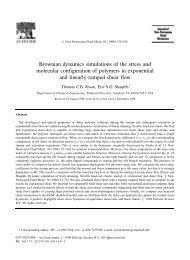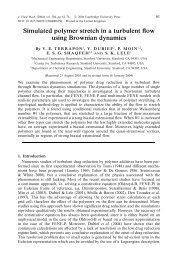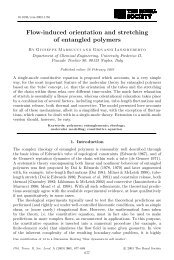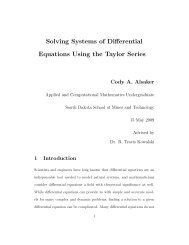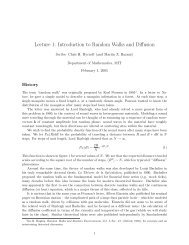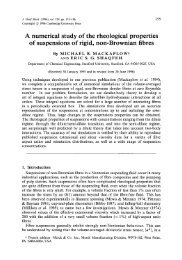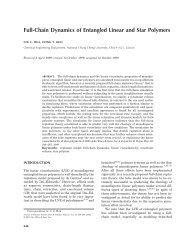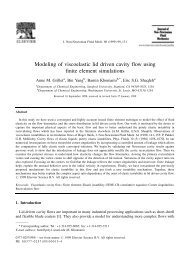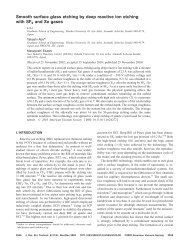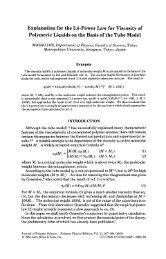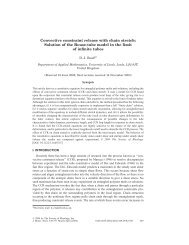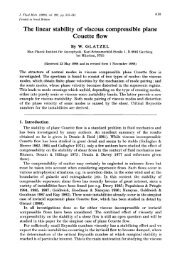Molecular modelling of entangled polymer fluids under flow The ...
Molecular modelling of entangled polymer fluids under flow The ...
Molecular modelling of entangled polymer fluids under flow The ...
Create successful ePaper yourself
Turn your PDF publications into a flip-book with our unique Google optimized e-Paper software.
38 CHAPTER 2. INTRODUCTION TO MOLECULAR RHEOLOGY<br />
tube model [Doi and Edwards (1986)]. A pom-pom molecule comprises <strong>of</strong> two q-armed<br />
Figure 2.13: A three armed pom-pom molecule (q=3)<br />
stars connected by a backbone section. This backbone section has no free ends so<br />
that reptation and retraction as outlined above are prevented by the branch points.<br />
<strong>The</strong> molecule relaxes through a hierarchical series <strong>of</strong> processes. First the free arms<br />
begin to relax in the same manner as a star <strong>polymer</strong>. <strong>The</strong> subtle difference here is<br />
that part <strong>of</strong> the the entanglement network, the backbone sections, are fixed so are not<br />
removed by dynamic dilution. Each time the arm retracts fully the branch point takes<br />
a diffusive hop. <strong>The</strong> dynamics <strong>of</strong> the backbone sections are controlled by these diffusive<br />
hops. At time-scales longer than the arm retraction time the motion <strong>of</strong> the backbones<br />
becomes that <strong>of</strong> a linear <strong>polymer</strong> in a tube formed by self entanglements <strong>of</strong> the backbone<br />
segments. <strong>The</strong> friction is concentrated at the ends <strong>of</strong> the chain and the diffusion<br />
rate is controlled by the free arm relaxation rate. Thus the molecular time-scales are<br />
influenced by the number <strong>of</strong> arms, q, through the dilution calculation. Variations <strong>of</strong> q<br />
change the relative concentration <strong>of</strong> arm and backbone material which has a secondary<br />
effect on both the chain end friction and the number <strong>of</strong> mutual entanglements between<br />
backbone sections. McLeish and Larson (1998) derived a detailed linear version <strong>of</strong> the<br />
model which explicitly computes the stress relaxation contribution from all parts <strong>of</strong> the<br />
molecule. However, for the purposes <strong>of</strong> this thesis their non-linear model is <strong>of</strong> more<br />
interest.<br />
Under non-linear response the dominant contribution to the deviatoric stress can<br />
be shown to come from the backbone sections. Since the friction felt by the backbone<br />
is concentrated at the branch points the chain stretch is uniform along the backbone.<br />
Counterintuitively, this means that a simpler model can be used for stretch in branched<br />
molecules than linear molecules. <strong>The</strong> pom-pom model describes the effect <strong>of</strong> an imposed<br />
deformation on a melt <strong>of</strong> identical pom-pom molecules. <strong>The</strong> configuration <strong>of</strong> the<br />
melt is described by three dynamical variables S, λ and s c . <strong>The</strong> tensor S =< uu ><br />
≈ ≈<br />
describes the pre-averaged backbone tube orientation (u is a unit vector parallel to<br />
a tube segment) and λ is the pre-averaged stretch <strong>of</strong> the backbone section which is<br />
defined as the ratio <strong>of</strong> the current length <strong>of</strong> the backbone to their equilibrium length.



